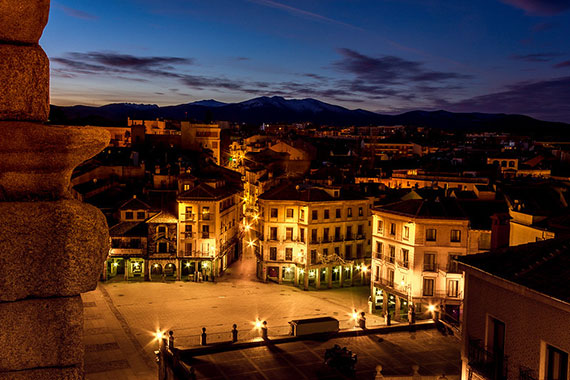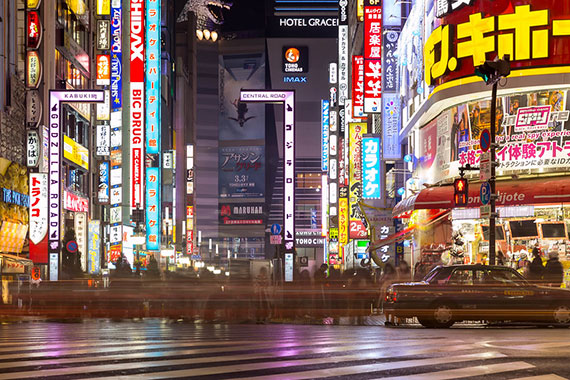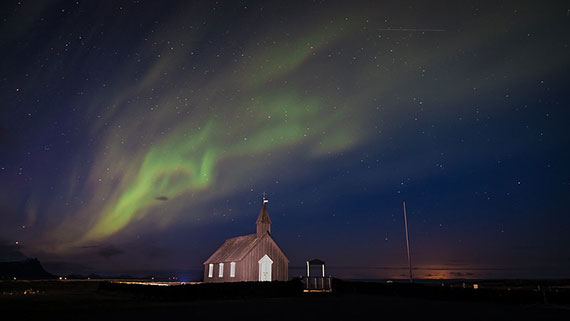Digital cameras offer a level of technology that was unimagined only a few short years ago. The funny thing is, the old techniques are still as important as ever.
A tripod is still an essential piece of equipment for good photography. For beginners, the purchase of a tripod is usually a sign that one is ready to move beyond the snapshot stage and get more serious about photography. But if you have managed without a tripod in the past, perhaps you have wondered if you should take the plunge, or continue to get by without. So here is the first question you need to answer: “Do I need a tripod?”

Photo by Nelson L.; ISO 100, f/14.0, 1.6-second exposure.
Now for the second question: “Why do I need a tripod?”
A tripod keeps your camera completely still, so you can take photos that will not be blurred by any movement of the camera caused by an unsteady hand.
There are two reasons why you might use a slow shutter speed for your photos. Sometimes the light is very low, and you need a slow shutter speed to get a good exposure. Or you may choose to use a slow shutter speed to capture a special effect. In either situation, your tripod will ensure that the camera is perfectly still and the photo will not be blurred.
An additional benefit is that the tripod allows you to compose a photo carefully, without having to concentrate on keeping the camera still in your hand. It is much easier to check that the horizon is level, and all parts of the photo are as you want them before you press the button.

Photo by Marco Verch Professional Photographer and Speaker; ISO 800, f/5.0, 1/30-second exposure.
Let’s assume for a moment that you have a tripod. Now for our third and final question: “When do I use my tripod?”
Some people will tell you you should never take a photo without a tripod below a certain shutter speed. The trouble is, different people recommend different speeds. Some photographers will tell you 1/125 of a second is the lower limit; other will recommend 1/60 or 1/30 second.
So who is telling you the truth? Actually, all of them. Because the truth is, it’s not that simple.
When you use a large lens to magnify your subject, you also magnify the effect of any camera movement. So if you use a telephoto lens, a shaky camera will affect your photo much more than if you use a wide-angle lens. So it could be that a photo you could take hand-held with a wide angle lens would require a tripod with a telephoto lens.
How do you know, then, when to use a tripod? This is a guideline that was recently told to me, and it is a good one to keep in mind.
Let your choice of shutter speed match the size of the lens. For example, if you are using a 200mm lens, you should be able to take photos without a tripod at speeds of 1/200 second or faster. Once your speed drops below 1/200 second, be sure to use your tripod.

Photo by Giuseppe Milo; ISO 200, f/2.8, 30-second exposure.
For a smaller lens, you can go with a slower shutter speed to match. So if you are using a standard lens (around 50–60mm) you could set your cutoff point at 1/60 second. Faster, and you can take the photo hand-held; slower, and you should use a tripod. With a wide angle lens of 28mm, your cutoff point would be 1/30 second.
There are some photographers who insist that all photos should be taken with a tripod, no matter what lens or shutter speed you use. This is simply not practical, but it does point to the simple fact that the tripod is always steadier than the hand. If a photo is important to you, it is worth going to some extra effort and leaving nothing to chance. So if in doubt, use a tripod, even when the shutter speed suggests you can get by without it.
Oh, and one more thing. Never, ever, ever take a photo slower than 1/30 second without a tripod.
About the Author:
Andrew Goodall writes for https://naturesimage.com.au/ and is a nature photographer based in Australia. He manages a gallery in Montville full of landscape photography from throughout Australia.
Like This Article?
Don't Miss The Next One!
Join over 100,000 photographers of all experience levels who receive our free photography tips and articles to stay current:






Your brain with your eye will position your image far better than a solid tripod. Of course there are times when a tripod is essential. Use your senses God gave you
I have been a dedicated photographer for around 50 years and taken thousands of images from a compact, developing my own prints and keeping equipment updated as it be on the market. I have been watching many expeditions on u tube and on 99.9% when arriving t at a potential site what is the first thing they do is to get the tripod out, unless in obvious situations i.e.macro/long lens Why. They start with their brain controlled mobile legs on a perfect day to find the best position. Next is to try to firmly position a 3 legged unforgiving tripods adjusting various knobs to position their cameras to exactly where their legs had previously positions them. Then it time to stand and wait until the light is just right or whatever hoping their tripods haven’t move/fallen our whatever. Could they not have been safely holding x £ equipment safely in their hands until their shooting time had arrive Oh camera shake, the cameras these days have it built into them, perhaps it makes them look like a professional.
You start with a slightly insulting “It depends on how seriously you take your photography.” You then proceed to prove that it is actually the type of photography you do – shutter speed, subject, etc.
I’m with Mr. Foster on this one. I recently went to the state fair and shot quite a number of photos in the poultry barn, which had terrible lighting (if you’re in a forgiving mood to call it that). Some display areas were outside of most natural and artificial lighting, requiring 1/15 s speed. In that situation, I didn’t have a tripod and would not have wanted to lug one around for 12 hours (and I still didn’t visit almost half the exhibits being there that long). Even with a tripod, it would have been very tricky to photograph the animals without pointing the camera down at that. I still captured some sharp images of the livestock exhibits. Granted, it does take practice, but I would consider adding a caveat of developing a strong knowledge of your cameras capabilities before working with a tripod, maybe even try shooting handheld in typical tripod photography situations to see what happens.
This is the best Tip ever from this site. It is a really well written article.
There is however, a notational problem. Apparently the author has confused the notation for F stop with the notation for fractions of a second.
125/sec is the lower limit; other will recommend 60/sec or 30/sec.
This notation would be read as 125 per second. Older folks will recognize 45 rpm or 45 rev/sec as the speed of a phonograph record 45 revolutions per second.
The shutter speeds should be written as 1/125 s or 1/125 sec if you are resistant to using modern notation. Why?
The time is only a small portion of a second, hence the fractional notation of 1/30 s. It just like more often used fractions such as the more familiar fractions such as ¼, ½, and ¾.
For goodness sake! the technical aspects of photography is difficult enough for beginners without ‘experts’ giving advice with technical errors.
I’m doomed … I’m cursed … I have taken some damn fine shots at slower than 1/30s WITHOUT A TRIPOD … I must be in league with the devil ! Or maybe just a low lt stage with no room reserved for the tripod but good hands and image stabilisation. Probably wouldn’t try it for a landscape or wildlife shot though … That is a bit of a silly blanket statement with no regard to photo style or situation.
Sorry